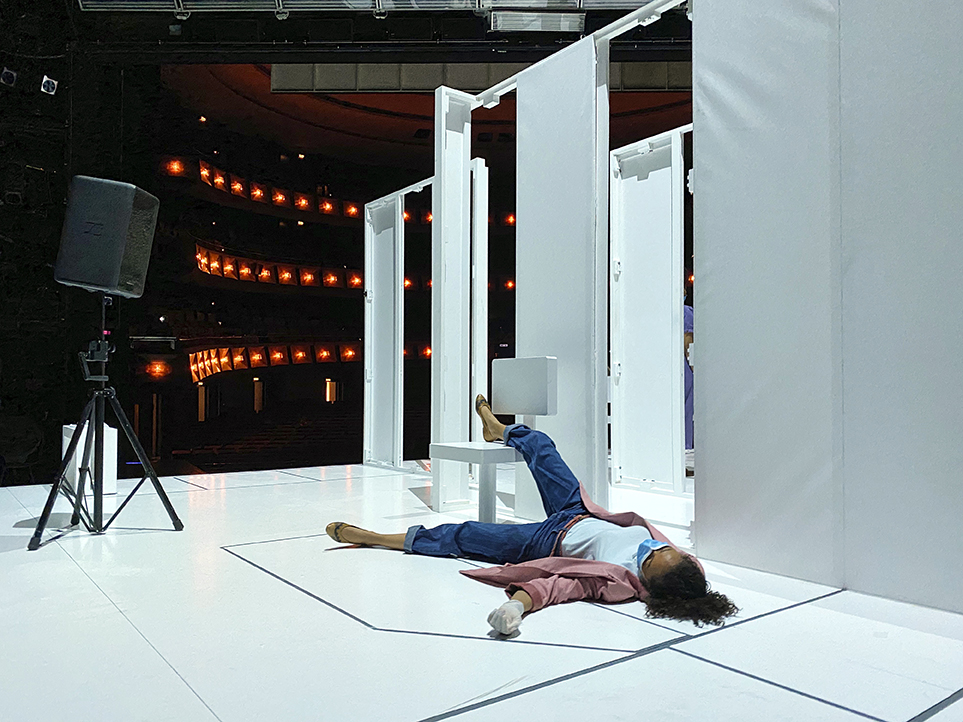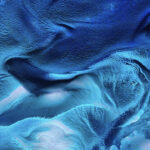
Art Richard Hamilton – ‘Cadaqués’
A body of work made by the British artist in the Spanish coastal town.
A number of idyllic seaside towns along the Mediterranean Sea have been frequented by various artists. Picasso, Matisse and Chagall stayed in the Cote d’Azur towns such as Vallauris and Antibes. The restaurant La Colombe d’Or in Saint Paul de Vence, has an impressive art collection donated by artists in exchange for room and board.
Many artists also stayed in Spanish coastal towns such as Ceret and Cadaqués. In the latter town, avant-garde artists, including Marcel Duchamp, Pablo Picasso, Salvador Dali and Richard Hamilton spent some time.
“Artists didn’t travel to seaside towns for a holiday, but merely as a different space to think and operate in another way,” says Rodolphe von Hofmannsthal, director at the David Zwirner Gallery, at the presentation of the exhibition Richard Hamilton ‘Cadaqués’. The upper room of the gallery is dedicated to a body of work made by the British artist in the 1970s in the fishermen’s town, in the North East of Spain. Von Hofmannsthal introduces the exhibition with Ashley Heath, a Hamilton enthusiast and founder and publisher of Arena Homme Plus and Pop, and Huc Malla, director of Galeria Cadaqués since 2003.
Marcel Duchamp invited Hamilton to Cadaqués to spend some time there when his wife, Terry O’Reilly, passed. He liked the town and after visiting Cadaqués for many years he bought a house there and invited other artists, like Mario Merz, Marcel Broodthaers, David Hockney and Joseph Beuys to come and visit him.
Many of the works in the David Zwirner exhibition were exhibited for the first time in the Galeria Cadaqués, founded by the architect Lanfranco Bombelli. Several works reference Cadaqués directly, like the city’s cathedral in ‘Altar Piece’. In this work Hamilton uses collage, a technique he used in one of his earliest Pop Art works, ‘Just What Is It that Makes Today’s Homes So Different, So Appealing?’ (1956).
 The cathedral also features in ‘Sunrise – progressives’ (1974). It comprises nine unique colour separated test prints, of the same image as a finished artwork and it lays bare the process of printmaking. It is interesting to compare Hamilton’s take on repetition with the silkscreen painting ‘Marilyn Dyptich’ by Andy Warhol (now on display in the show ‘Media Networks’ at Tate Modern). In this famous Pop Art work, Warhol repeated the same publicity photograph of Marilyn Monroe from the film Niagara, representing the mortality of The Blonde Bombshell, using the fading effect of the silkscreen process.
The cathedral also features in ‘Sunrise – progressives’ (1974). It comprises nine unique colour separated test prints, of the same image as a finished artwork and it lays bare the process of printmaking. It is interesting to compare Hamilton’s take on repetition with the silkscreen painting ‘Marilyn Dyptich’ by Andy Warhol (now on display in the show ‘Media Networks’ at Tate Modern). In this famous Pop Art work, Warhol repeated the same publicity photograph of Marilyn Monroe from the film Niagara, representing the mortality of The Blonde Bombshell, using the fading effect of the silkscreen process.

 Hamilton was also good in creating publicity for himself. On display are enamel signs, an ashtray and a carafe where Hamilton appropriated the logo of Ricard, an Anise-flavoured liqueur, at the time a very popular drink along the northern coast of the Mediterranean. Hamilton created his own ‘cocktail’ and came up with the simple idea to stick an “H” between the “C” and the “A”, altering the logo to his first name. It is his take on the readymade and is served as an advertisement for himself and his show at Galeria Cadaqués. During the show, Paul Ricard, owner of the liqueur provided for actual Ricard signs to be interspersed with Hamilton’s versions. The artist was amused by mixing his Richard ashtray with the original Ricard ashtray went unnoticed by some. A photograph was taken of him sitting on the terrace of the Melitón bar in Cadaqués having a drink with the Richard sign behind him on the wall. He created a slightly surrealistic event that Dali would have appreciated.
Hamilton was also good in creating publicity for himself. On display are enamel signs, an ashtray and a carafe where Hamilton appropriated the logo of Ricard, an Anise-flavoured liqueur, at the time a very popular drink along the northern coast of the Mediterranean. Hamilton created his own ‘cocktail’ and came up with the simple idea to stick an “H” between the “C” and the “A”, altering the logo to his first name. It is his take on the readymade and is served as an advertisement for himself and his show at Galeria Cadaqués. During the show, Paul Ricard, owner of the liqueur provided for actual Ricard signs to be interspersed with Hamilton’s versions. The artist was amused by mixing his Richard ashtray with the original Ricard ashtray went unnoticed by some. A photograph was taken of him sitting on the terrace of the Melitón bar in Cadaqués having a drink with the Richard sign behind him on the wall. He created a slightly surrealistic event that Dali would have appreciated.
 In the 1950s, Hamilton was a key member of the Independent Group. The group consisted of artists, writers and architects. Their vision on contemporary culture was to integrate it with mass mediated images and new technology. It is considered to be the precursor of the Pop Art movement in Britain and America.
In the 1950s, Hamilton was a key member of the Independent Group. The group consisted of artists, writers and architects. Their vision on contemporary culture was to integrate it with mass mediated images and new technology. It is considered to be the precursor of the Pop Art movement in Britain and America.
During the introduction, Heath reads out a paragraph from the article ‘Art in a Coke Climate’ written by the art critic, David Sylvester, printed in the Sunday Times in 1964. Sylvester observed that Pop Art culture was splitting into two directions, Coca-Cola culture and wine culture.
“The point is not whether Coca-Cola culture is wiser and nicer than wine culture; the point is that it is a culture – a set of tribal tastes and customs which implies certain values and customs, which implies certain attitudes and a conception of what life ideally should be.”
I asked Heath whether he thinks British Pop culture is wine culture. “There was no question; American Pop Art was Coca-Cola culture”, Heath says. “I think the Independent Group was obsessed with that post-war burgeoning Coca-Cola culture. We can see that Hamilton, with his work ‘My Marilyn’ and ‘A Little Bit of Roy Lichtenstein’, is looking at these artists [of the Coca-Cola culture].
Was British Pop Art wine culture? I don’t know. It was true that Hamilton in Cadaqués was enjoying the good life with all these incredible, artistic people. Sitting in the sun, drinking great wine and later going to El Bulli, arguably then the best restaurant in the world. The way I would put it, in terms of Hamilton’s relationship with wine culture, is that he always talked in a derisory fashion about Post-War British Art. He thought it was dusty, provincial and parochial – poor wine culture. He became interested in European Culture, looking at Gerhard Richter and Blinky Palermo’s work, artists from the German contemporary art scene. He also did a piece ‘Picasso’s Meninas’ that combines the composition of Diego Valásquez’s ‘Las Meniñas’ with the graphic stylings of Pablo Picasso. Valásquez, that is very good wine culture”. [laughs]
 Heath comments that he is not especially interested in British Pop Art, per se. He is more interested in Hamilton and other artists from that era such as John Latham, Keith Arnatt and Bob Law. Has Hamilton been a huge influence on Heath’s publication ‘Arena Homme Plus’ and Heath himself?
Heath comments that he is not especially interested in British Pop Art, per se. He is more interested in Hamilton and other artists from that era such as John Latham, Keith Arnatt and Bob Law. Has Hamilton been a huge influence on Heath’s publication ‘Arena Homme Plus’ and Heath himself?
“The spirit of Hamilton as a man translates into Arena Homme Plus. It is a men’s magazine for slightly maverick, bohemian men albeit successful, stylish men. Hamilton was always stylishly dressed. We believe magazines can have their own kind of magic, that an ‘epiphany’ should be part of the promise. On a simplistic level, Hamilton was always an inspired consumer and stylish.”
He continues: “As a formally trained artist, Hamilton was always looking at the cutting edge of technology, of product design, of conceptual art and he was evaluating it all against these older cultural revolutions that he still held so precious. He would refer to Charles and Ray Eames, to Dieter Rams, to Marcel Breuer in his work. He considered Marcel Duchamp to be one of the intellectual heavyweights of the century, from any discipline, and I think he was right. When you immerse yourself in Hamilton’s world, so much can be learned from his particular take on people like Duchamp and Paul Klee and of course James Joyce; or from his colourful riffs on the theories of Carl Jung or the ideas of Bauhaus. In that respect he really informs my magazine company, we do look to join the dots a bit, without necessarily spelling it out or being too obvious, either.”
 “To me, personally, Hamilton is many things, not least a man who actually enjoyed myth and mystery. But he did provide me with a coherent world in which to consider all art as well as more commercial graphic design too. Hamilton was a very good graphic artist and technical draughtsman with this obsession regarding perspective. To be honest, he is still sometimes derided by other artists as simply a graphic artist, which is patently ridiculous. To me he was and is a twentieth century Master.”
“To me, personally, Hamilton is many things, not least a man who actually enjoyed myth and mystery. But he did provide me with a coherent world in which to consider all art as well as more commercial graphic design too. Hamilton was a very good graphic artist and technical draughtsman with this obsession regarding perspective. To be honest, he is still sometimes derided by other artists as simply a graphic artist, which is patently ridiculous. To me he was and is a twentieth century Master.”
Written by Thierry Somers
Richard Hamilton and Sign (1975) at the Bar Melitón, Cadaqués, Spain, 1975, Courtesy David Zwirner, New York/London
Richard Hamilton, Just what was it that made yesterday’s homes so different, so appealing? On paper, print, Digital print on paper, image: 260 x 250 mm, Presented by the artist 2004, © Richard Hamilton 2016. All rights reserved, DACS
Richard Hamilton, Sunrise – progressives, 1974, Collotype on Schoeller Elfenbein-Karton paper in nine (9) parts, Framed, each: 18 1/8 x 22 1/8 x 1 1/4 inches (46 x 56 x 3 cm), Paper, each: 16 5/8 x 20 1/2 inches (42 x 52 cm), Overall: 57 1/2 x 69 1/2 x 1 1/2 inches (146 x 176 x 3 cm) Art: © Estate of Richard Hamilton; courtesy David Zwirner, New York/London










